Research
Research
Aircraft
de Havilland Mosquito
The de Havilland Mosquito, one of the most successful aircraft of WWII and surely the most versatile. The ‘Mossie’ was used by Bomber Command as both pathfinder and light-bomber. It also served with the RAF in fighter-bomber, night fighter, maritime strike and photo reconnaissance roles. Until the advent of German jet fighters, it was the fastest aircraft on either side of the conflict yet could carry a bomb load to match the four-engine Boeing B-17 to distant targets. The Mosquito truly lived up to its moniker – ‘The Wooden Wonder.’
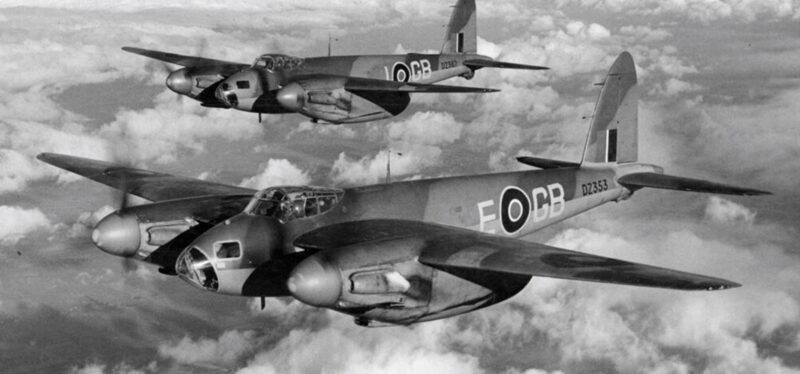
de Havilland Mosquito IVs of 105 Squadron.
(Credit: Charles Brown Collection, RAF Museum)
Originally conceived,in response to the British Air Ministry issued Specification P.13/36, as an unarmed fast bomber, when Sir Geoffrey de Havilland first pitched his idea for a two-seater bomber made of wood with no armament, few people were willing to accept his design.
However, with de Havilland’s perseverance the Mosquito went on to become one of the most successful and popular aircraft of the Second World War. Its sleek design, powered by twin-Merlins, together with lightness (in part due to no defensive armament or armour) allowed the Mosquito to travel at speeds in excess of four hundred miles per hour to escape from enemy fighters.
Unusually, the Mosqito’s airframe was constructed mostly of wood. Most of the aircraft was made of plywood. The fuselage was a frameless shell made of balsa wood sandwiched between sheets of birch.This was a major advantage during a time of acute shortages of light metal alloys. It also enabled the use of craftsemen in construction who had skills not required for other aircraft manufacturing.
The Mosquito was much loved by pilots, seemingly capable of any role it was asked to take on. As a bonus its speed meant that aircraft were capable of completing two raids in one night.
This performance meant the Mosquito’s use evolved during the war into many roles, both within Bomber Command and elsewhere within the RAF. Uniquely it flew with Fighter Command, Coastal Command and Bomber Command.
The first Mosquito protype flew in November 1940. No. 105 Sq. became the first unit to receive aircraft year later. Together with No.139 Sq. they flew low-level precision raids on high prestige targets. In June 1943, these squadrons were transferred to 8(PFF) Group in the pathfinder role, but also flying spoof raids to distract from the bomber stream.
Within Bomber Command, the Mosquito made an important contribution in the pathfinding role, but it was with the squadrons of the LNSF (Light Night Strike Force) that it achieved its most dramatic results.
Later 128, 571 and 608 squadrons joined the LNSF, conducting regular nocturnal raids over Germany, guided to targets by Oboe-equipped Pathfinders and able to bomb with precision seldom achieved by the heavies.
The Dambuster squadron, 617 used Mosquitos for low-level target marketing, while Mossies were also used by 100 (BS) group for RCM and intruder missions.
Later marks were fitted with bulged bomb bays and one hundred gallon drop tanks for extra capability and the definitive Mk XVI had a pressurised cockpit, providing an operational ceiling of 37,000 feet at over 400mph.
Bomber Command Mosquitos flew over 39,000 sorties, for the loss of just 254 aircraft. At 0.6% this was the lowest loss rate of any bomber aircraft in the war -a remarkable statistic for a remarkable aircraft.
A Kiwi Mosquito Pilot’s memories
“The Mossie was always my favourite type; even later in the 1950s and 60’s, when flying jets, the memory of how good the Mossie was, has never left me” recalled Bill Simpson in Peter Wheeler’s book, Kiwis Do Fly.
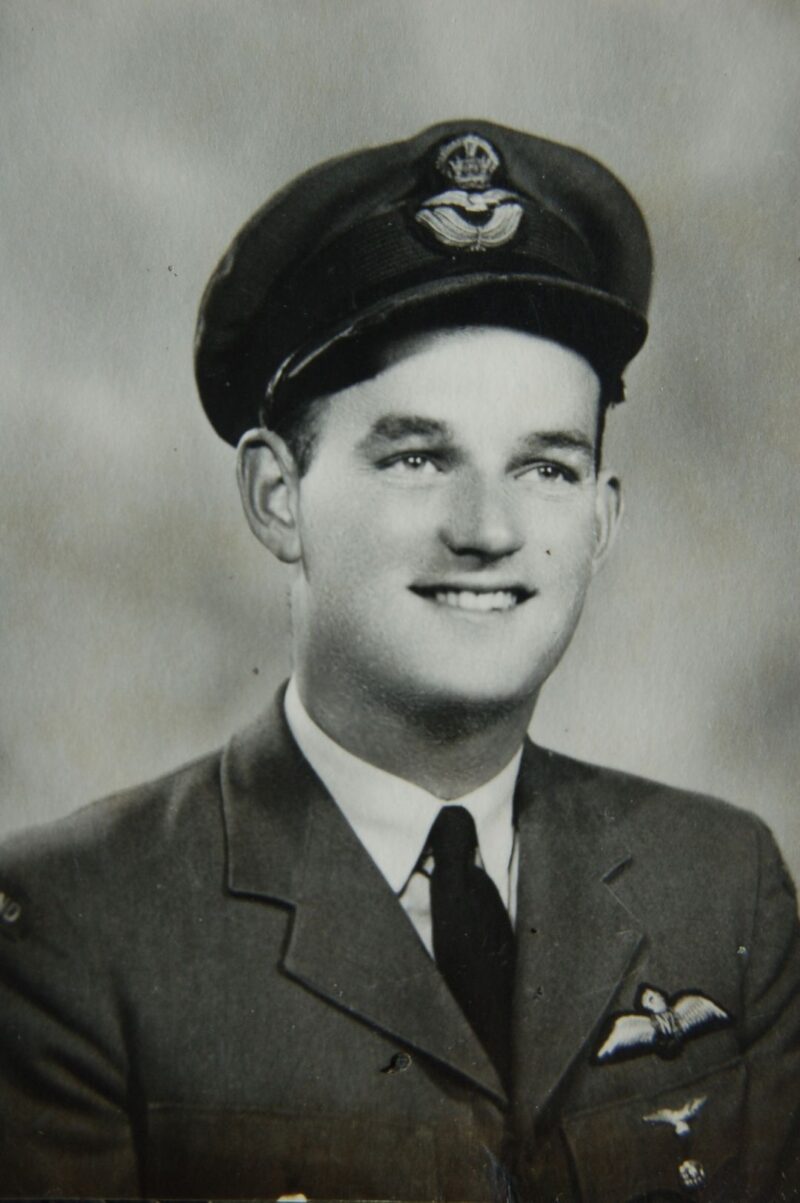
Wing Commander Bill Simpson DFC 1945.
(Credit: NZBCA Archives)
“On 109 (PFF) Squadron I had some great moments in them. On March 2, 1945, in MM295-P, the famous Grim Reaper with at least 120 Ops, I marked for 858 Bomber Command aircraft over Cologne. Ten days later I was marking again for 1008 heavy bombers over Dortmund (in MM114-G)”.
“Both were incredibly heavy raids and an amazing sight as something like 8,000,000 lbs of high explosive was dropped on a single target. It was unbelievable that anything could survive such as destruction, but it did.”
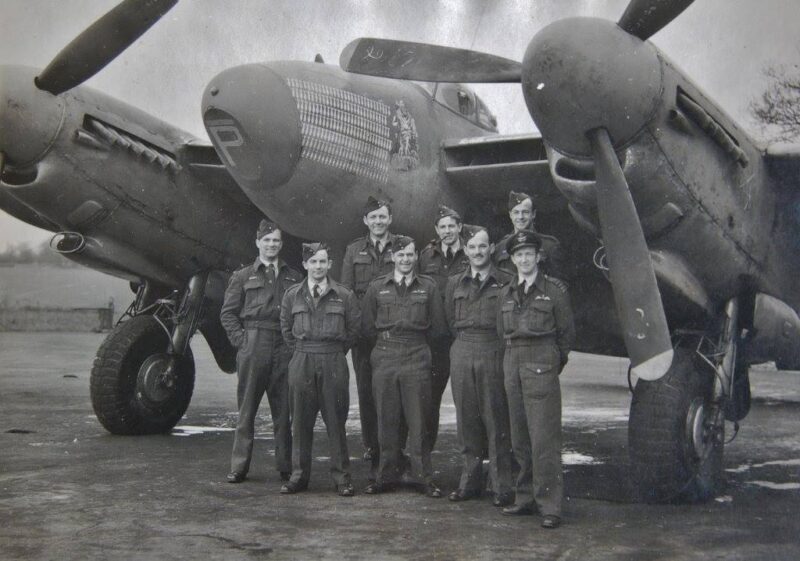
Kiwi pilots on No. 109 Squadron standing with the famous Mosquito, The Grim Reaper, (MM295-P). This aircraft flew a remarkable number of ops, sometimes two in one night, but with different crews.
(Credit: NZBCA Archives)
Post-war, Simpson was flying in the Central Signals Establishment. “I was flying out of Watton on radar development was taking a Mossie up to 58,000 feet over Buchan. It took a while to get there, and she wasn’t happy just mushing along, but what an aircraft. It gave the GCI radar boys who were tracking us something to think on, as 60,000 feet was at the limit of most of the RAF jet fighters of the time”.
Post war NZ purchased over 70 Mosquitoes from RAF stocks and mixed RAF/RNZAF crews ferried the aircraft down to NZ. A further eight dual control versions were bought from Australia. The purpose was to form four squadrons. A change in planning saw only 22 used and mainly by 75 squadron.
Fighter ace Johnny Checketts together with two-tour Bomber Command navigator Bunny Burrows set a trans-Tasman record of 5 hours flat from Bankstown to Ohakea. in April 1947.
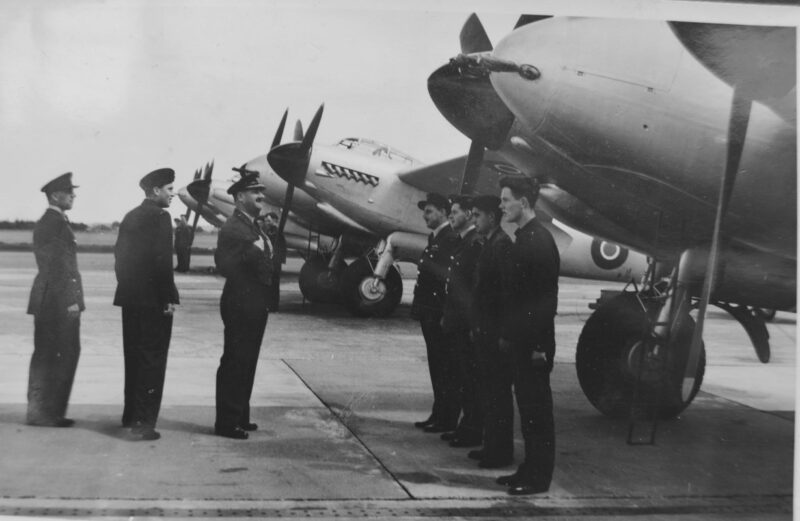
Squadron inspection at Ohakea. 75 Sq. CO Mac Baigent (2nd from left) also commanded the squadron in 1944/45 when it flew Lancasters and later Lincolns. (Credit: NZBCA Archives)
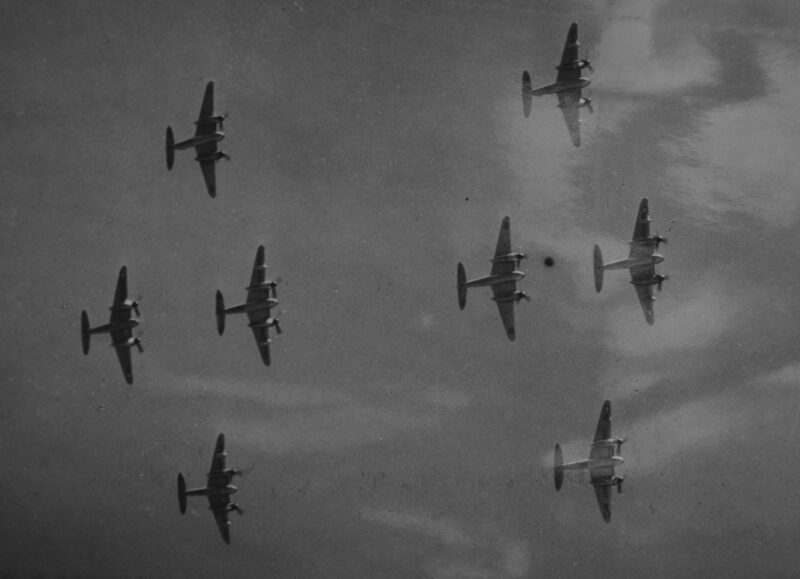
75 Squadron in formation over Mangere, 20 March 1949.
(Credit: NZBCA Archives)
References:
- Peter J Wheeler, “Kiwis Do Fly” (2010).
- NZBCA Archives
November 3, 2024